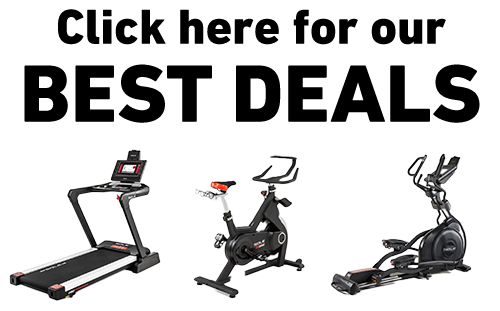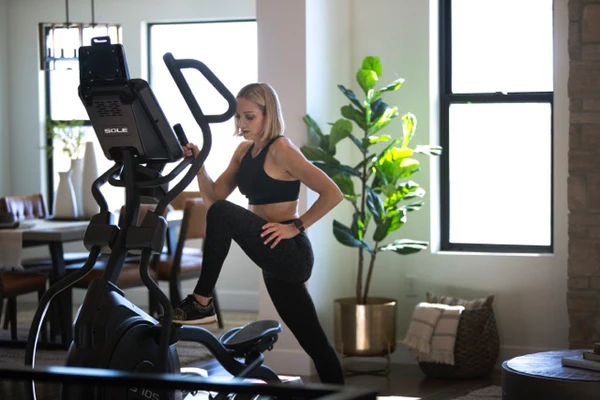Key Takeaways
- Always plan your route before moving your elliptical to avoid obstacles.
- Though you can move the elliptical just as it is - you can also disassemble the elliptical for easier and safer transportation.
- Use proper ergonomic lifting techniques to prevent injuries.
- Protect floors and walls with moving blankets or pads to prevent scratches too.
- Consider professional help if the elliptical is too heavy or complex to move.
|
At SOLE Fitness, we’re proud to offer the best treadmills for your home or gym. These machines are crafted to meet the highest standards of quality and performance, ensuring they are ideal for anyone - from fitness novices to seasoned athletes. Featured Products SOLE Ellipticals: Priced from $1,199.99, SOLE ellipticals are known for their ergonomic design, durability, and affordability. They provide a quiet, smooth workout with intuitive consoles, adjustable stride lengths, incline options, and heart rate monitoring, ensuring a comprehensive exercise experience. |
Why Moving an Elliptical Correctly Matters
Moving an elliptical machine correctly is crucial for several reasons. Improper handling can lead to personal injury, especially given the weight and awkward shape of the equipment. By using proper lifting techniques and teamwork, you can significantly reduce the risk of strains or accidents.
Ensuring that the elliptical is moved safely helps prevent damage to both the machine and your home—scratches on floors or walls can be costly to repair. A well-executed move preserves the integrity of the elliptical, ensuring it functions optimally in its new location.
When to Move Your Elliptical
Here are some common examples:
- Relocating to a New Home: When moving residences, transporting your elliptical is often essential to maintain your fitness routine. This may involve disassembling the machine for easier transport and maneuvering through doorways, hallways, and stairs.
- Rearranging a Home Gym: If you're reorganizing your workout space to create a more efficient layout or to accommodate new equipment, you may need to move the elliptical within the same room or to a different area of your home.
- Moving Up or Down Stairs: Whether you’re placing the elliptical in a basement gym or moving it to a second floor, using the stairs can be a significant challenge. This typically requires additional assistance to ensure safety and stability during the move.
- Transporting for Repairs or Maintenance: If your elliptical requires servicing or repair, you may need to move it to a different location, such as a fitness equipment repair shop.
- Storing for Seasonal Use: Some individuals choose to store their elliptical during certain times of the year, such as summer, when outdoor activities are more prevalent. This may involve moving the machine to a storage area or garage.
Preparation Before the Move
Recommended Tools and Equipment
Before you start moving your elliptical, gather all the necessary tools and equipment. Here's a list of what you'll need to make the moving process smoother:
- Moving blankets or pads
- Furniture dollies
- Screwdrivers and wrenches
- Heavy-duty straps
- Protective gloves
Clearing Your Path
One of the first steps in moving your elliptical is to clear the path from its current location to its new home. Remove any furniture, rugs, or other obstacles that could get in the way to prevent tripping and make the move much more straightforward.
Measuring Doorways and Hallways
Ellipticals can be quite bulky - so, measure doorways and hallways to ensure the machine can pass through without any issues. Measure the dimensions of the elliptical and compare them with the width and height of your doorways and hallways.
If you’re moving a SOLE elliptical, check its dimensions on the elliptical product page. For example, the E95 has a dimension of 83"L x 34"W x 70"H and weighs 242 lbs. So, make sure your elliptical fits through all doorways and hallways to avoid getting stuck halfway. If it’s too heavy to move, you should carry it with a friend - if possible.

Protecting Floors and Walls
Moving heavy equipment like an elliptical can easily scratch floors and walls. To avoid this, use moving blankets or pads to cover these surfaces, securing them with tape if necessary to keep them in place. You can wrap your elliptical with protective sheets like bubble wraps.

Moving the Elliptical Without Disassembly
Lift and Load
Tilt the elliptical slightly and place it onto the dolly or hand truck. If the machine has transport wheels, use them to guide it onto the dolly. Ensure the machine is stable and secure on the dolly.
Transport
Carefully roll the dolly to your desired location. If using the stairs, ensure you have at least two people to help, distributing the weight evenly and moving slowly to avoid injury.
Moving the Elliptical With Disassembly
Removing Pedals and Handlebars
Disassembling your elliptical can make it easier to move. Start by removing the pedals and handlebars, using a screwdriver or wrench to detach these parts. Make sure to keep all screws and small parts in a labeled bag so you don't lose them.
Detaching the Console
The console is another part that should be removed - carefully unplug any wires connected to the console and use a screwdriver to detach it. Place the console in a safe, padded area to prevent damage. Here’s how the console looks for our E35 model.

Storage of Small Parts
After disassembling, store all small parts in a labeled container - this will make reassembly much easier and prevent any parts from getting lost during the move.
Proper Lifting Techniques
Once you've disassembled your elliptical, it's time to move the parts to their new location. Lifting heavy objects like an elliptical can be risky if not done correctly, so always bend your knees and keep your back straight when lifting. Hold the object close to your body to maintain balance and reduce strain on your back.
"Lift with your legs, not your back, to avoid injuries."
Communicate with your helpers - use clear commands and move in sync to prevent accidents. If the elliptical is too heavy, ask for additional help or consider using lifting straps for better grip and control.

C: The image above shows the correct lifting method for heavy items that protects your back from injuries (image is courtesy of HSE Blog).
Using Furniture Dollies
Furniture dollies can make the moving process much easier. Place the elliptical base on the dolly and secure it with heavy-duty straps, ensuring it is balanced and won't tip over during the move.
Push the dolly slowly and carefully, especially when moving through tight corners or narrow hallways. If you're moving the elliptical over a long distance, take breaks to rest and check whether the straps are still secure.

Reattaching Pedals and Handlebars
After successfully moving your elliptical to its new location, the next step is to reassemble it. Start by reattaching the pedals and handlebars - refer to the user manual for specific instructions on how to do this. Use the screws and small parts you stored earlier, ensuring they are tightened securely.
Make sure the pedals and handlebars move smoothly and are properly aligned. If you encounter any resistance or misalignment, double-check the connections and make adjustments as needed.
Securing the Console
The console is a critical component of your elliptical, so take extra care when reattaching it. Plug in any wires and secure the console with the appropriate screws, then test the console to ensure it powers on and all functions are working correctly.
If you experience any issues with the console, consult the user manual or contact customer support for assistance. Resolve any problems before using the elliptical to avoid further complications. Check our YouTube channel for assembly videos for some of our elliptical models.
Final Tips and Precautions
Avoiding Common Mistakes
One common mistake is underestimating the weight and size of the elliptical. As such, you need to always have enough people to help and use the proper equipment to avoid injuries and damage. Another mistake is failing to measure doorways and hallways, leading to difficulties during the move.
Maintaining Your Elliptical After Relocation
Once your elliptical is set up in its new location, perform a maintenance check. Lubricate moving parts, tighten any loose screws, and clean the machine to ensure it operates smoothly. Regular maintenance will prolong the life of your elliptical and keep it in top condition.
When to Call Professionals
If you find the moving process too challenging or risky, consider hiring professional movers. They have the experience and equipment to handle heavy and bulky items safely. It's better to invest in professional help than risk injuries or damage to your elliptical and home.
Move Your Ellipticals Safely
Moving an elliptical requires careful planning and execution to avoid damage and ensure safety. Key steps include clearing your path, measuring doorways, protecting floors and walls, using proper lifting techniques, and disassembling the machine if necessary. By following these steps, you can move your elliptical smoothly and safely.
SOLE ellipticals are designed with durability and performance in mind, making them a valuable investment for your home gym. Properly moving and maintaining your SOLE elliptical will ensure it remains in excellent condition, providing you with a reliable and effective workout experience for years to come. Take care of your equipment, and it will take care of your fitness needs.
Frequently Asked Questions (FAQ)
How many people are needed to move an elliptical?
It's recommended to have at least two people to move an elliptical to ensure the weight is distributed evenly and the risk of injury is reduced.
Can I move an elliptical by myself?
Moving an elliptical by yourself is not advisable due to its weight and size - having at least one helper makes the process safer and more manageable.
What should I do if my elliptical is too heavy to lift?
If your elliptical is too heavy to lift, consider disassembling it into smaller parts or using furniture dollies to transport it. Alternatively, hire professional movers to handle the task.
What should I do before moving my elliptical?
Before moving your elliptical, plan your route to avoid obstacles, gather necessary tools and equipment such as moving blankets, dollies, and wrenches, and measure doorways and hallways to ensure the elliptical can pass through easily. Clearing the path and protecting floors and walls with moving blankets are also essential steps.
How can I safely move an elliptical without disassembling it?
To move an elliptical without disassembling it, tilt the machine slightly and place it onto a dolly or hand truck. Use the elliptical transport wheels if available. Secure the elliptical on the dolly, ensure it's stable, and carefully roll it to the desired location. If using stairs, have at least two people to help distribute the weight evenly and move slowly.



Leave a comment
This site is protected by hCaptcha and the hCaptcha Privacy Policy and Terms of Service apply.